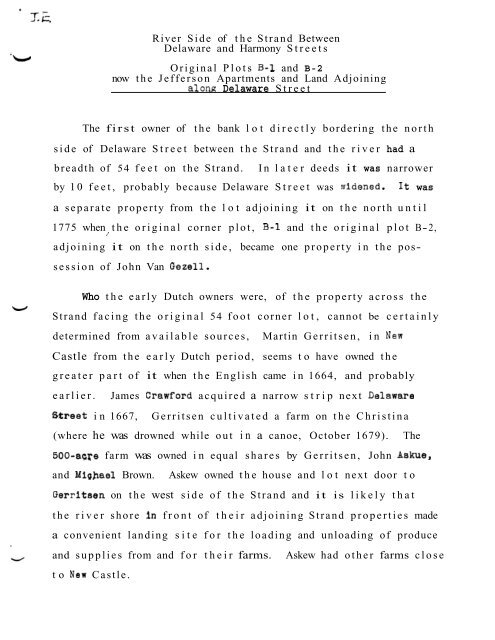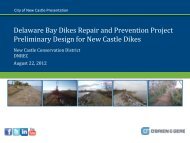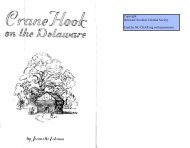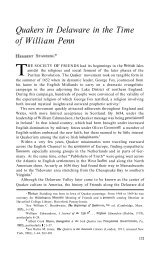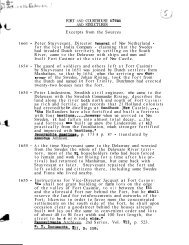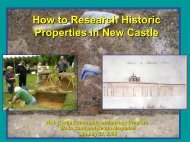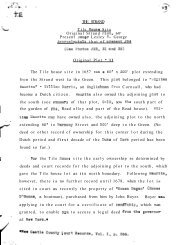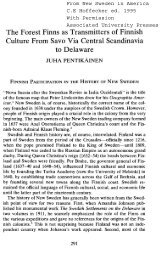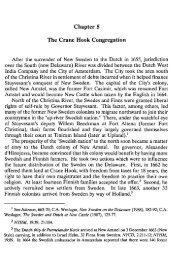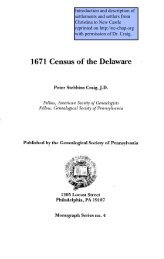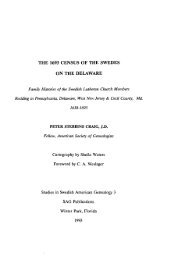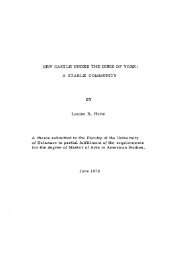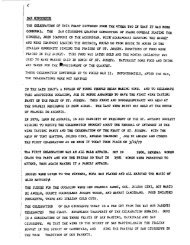Eckman - NC CHAP
Eckman - NC CHAP
Eckman - NC CHAP
Create successful ePaper yourself
Turn your PDF publications into a flip-book with our unique Google optimized e-Paper software.
w<br />
River Side of the Strand Between<br />
Delaware and Harmony Streets<br />
Original Plots B-1 and B-2<br />
now the Jefferson Apartments and Land Adjoining<br />
alon~ Delaware Street<br />
The first owner of the bank lot directly bordering the north<br />
side of Delaware Street between the Strand and the river had a<br />
breadth of 54 feet on the Strand. In later deeds it was narrower<br />
by 10 feet, probably because Delaware Street was widened. It was<br />
a separate property from the lot adjoining it on the north until<br />
1775 when the original corner plot, B-1 and the original plot B-2,<br />
/<br />
adjoining it on the north side, became one property in the pos-<br />
session of John Van Gezell.<br />
Who the early Dutch owners were, of the property across the<br />
Strand facing the original 54 foot corner lot, cannot be certainly<br />
determined from available sources, Martin Gerritsen, in New<br />
Castle from the early Dutch period, seems to have owned the<br />
greater part of it when the English came in 1664, and probably<br />
earlier. James Crawford acquired a narrow strip next Oelaware<br />
fZtreet in 1667, Gerritsen cultivated a farm on the Christina<br />
(where he was drowned while out in a canoe, October 1679). The<br />
500-aqre farm was owned in equal shares by Gerritsen, John Askue,<br />
and Migfiael Brown. Askew owned the house and lot next door to<br />
Gerriteen on the west side of the Strand and it is likely that<br />
the river shore In front of their adjoining Strand properties made<br />
a convenient landing site for the loading and unloading of produce<br />
and supplies from and for their farms. Askew had other farms close<br />
to Iew Castle.
In 1688 a Robert Evans (probably of ~hiladelphia) acquired<br />
all of Crawfard's and S-erritsen's property on the west side of<br />
the Strand and presumably the use of the waterfront opposite. The<br />
next transfer of this property, to James Xiller in 1703, coming<br />
after Penn's grant of the water lots to the owners on the Strtind,<br />
involved a legal grant to the lot opposite. The bank lot, 54 feet<br />
wide by 600 deep was resurveyed for Lfiller by George Deakyne in<br />
1708. From that time this corner bank lot wss owned by the sev-<br />
eral successive owners of the corner property across the street<br />
until John VanGezell Sr. by his w i l l of 1787 left - "all those<br />
two messuages on the s.e. side of Front Street n to George Read<br />
Sr., his executor, for the payment of all debts against him.<br />
These two properties were the corner bank lot and the 62-1/2 foot<br />
lot adjoining to the north.<br />
The owners of #4 the Strand and the water lot opposite, be-<br />
tween James Miller and JohnVanGezell, were W i l l i a m Houston and his<br />
brother Anthony Houston, Jonathan Houston, sonof Anthony, who sold<br />
to Sol. John French in 1726; David French and his heirs from 1729<br />
to 1762 when it was sold to Governor James Hamilton of Philadelphia<br />
to complete a purchase begun by his father Andrew Hamilton. Gov-<br />
ernor Hamilton sold to George Read Sr. in 1774, and Read sold to<br />
John VanGezell in 1775.<br />
John VanGezell at the time of this purchase lived at #6 the<br />
Strand in the house he had built to replace or incorporate a smaller
house that was on the plot in 1723 when he bought the 62-1/2 foot<br />
lot, #6 and #8, from the heirs of Dr. Samuel Monkton of ?hiladel-<br />
phis for 75 pounds. This included the 62-1/2 foot bank or water<br />
lot opposite. VanGezell left #6 and #4 as house and gardsn to<br />
his daughter G'ertrude. The double bank lot opposite, which was<br />
left to George Read Sr. to pay VanGezellls debts, has remained<br />
one property since that time.<br />
Before John VanGezell bought B-2, the north part of the river-<br />
side property from the heirs of Dr. Samuel Monkton in 1723, it be-<br />
longed so far as can be determined, in use at least, to Martin<br />
Gerritsen and John Askue, and then to Hendrick Jansen who bought<br />
C them from the Strand site opgosite in 1675. Jansen's heirs sold<br />
C<br />
in 1708 to Thomas Tresse Sr., of Philadelphia, and the heirs of<br />
Tresse to Dr. Monkton. Jansen's heirs, Tresse and Dr. Monkton<br />
all had legal title to the bank lot.<br />
Jansen was probably a farmer like Gerritsen and Askew;<br />
Tresse was an ironmonger; the Philadelphia physician may have<br />
bought for investment because of the wharf rights, or as moat<br />
early physicians had to have other means of support besides their<br />
profession, to make a livlihood, he may have had a business for<br />
which the house on the Strand and the wharf in front were assets,<br />
John VanGezell was a sadler and shopkeeper. Indentures indicate<br />
that he improved the bank lot property. He mortgaged it to<br />
Richard Grafton in 1729, but cleared the mortgage within two yeare,
e<br />
In 1737 VanGezell had the bank lot resurveyed. The return<br />
of this survey describes the property as beginning on the Strand<br />
6" from the wall of nis mother's house (#9) leaving 6" for eves-<br />
drop, and extending southwest along the Strand 62-1/2 feet. This<br />
plot was divided into a 2 foot strip next his mother's house, 30<br />
feet which he had previously sold to Anthony Dowdall, 30-1/2 feet<br />
on the south which he kept. Dowdall's part of the lot was sold<br />
by the sheriff in 1753 to Yiilliam dtwood of Philadelphia, mer-<br />
chant, who died in 1750 leaving the property to his cousin At-<br />
wood Shute. After several transfers among members of the Shute<br />
family, John VanGezell bought it back in 1760 for 12 pounds, with<br />
all buildings, wharfs, landings and improvements.<br />
How long the two bank lots left by John VanGezell in 1787<br />
remained in the hands of his executor, George Read Sr., has not<br />
been discovered in this search. The property was in the hands of<br />
Riddle and Bird, merchants, in the early 1800's. On the site of<br />
this double bank lot on the Strand side was a dwelling and store;<br />
behind this building toward the river were a warehouse, stables<br />
and a wharf. The firm of Riddle and Bird sold supplies to the<br />
navy, and when this business was interupted, they failed in 1810.<br />
John Bird died soon afterward of a heart attack, leaving his wife<br />
Elizabeth VanLeuvenigh, daughter of Zachariah, and seven children.<br />
One of them, Robert Montgomery Bird, became a distinguished play-<br />
rright of hia day.
After the death of Bird, James Riddle carried on a merchan-<br />
dising business alone. The great fire of 1824 started in the<br />
stable at ths back of the property. A contemporary newspaper<br />
account of its origin was that a steam packet ship at the wharf,<br />
belching sparks from its stack w'nen firing up, caused the fire.<br />
James Riddle rebuilt after the fire, the large dwelling and store<br />
afterward used as an inn.<br />
James Riddle died in 1833*, leaving two sons, John and<br />
Gunning Bedford Riddle, who sold the property for $4,510, des-<br />
cribed as "105' on Front Street, 600' deep with a new three-story<br />
brick dwelling house and store thereon erected." The purchaser<br />
was Elihu Jefferson who lived in the house and continued the<br />
store, as a merchant, until his death. As the property of his<br />
widow, it was sold by the sheriff in 1876 for $6,750 to William<br />
Herbert. W i l l i a m Lauebson and his wife Hannah, and then the<br />
Equitable Trust Company held mortgages or had interest in the<br />
property during Herbert's ownership. In 1892, the Equitable<br />
Trust Company and Nilliam Herbert sold to Charles Hoffman for<br />
$11,500.<br />
Charles Hoffman renovated and improved the dwelling, store,<br />
and stablea and opened a hotel which he called the Jefferson House.<br />
* Andrew C. Gray settled the James Riddle estate.
The large letters of this nme painted across the Delaware Street<br />
front of the building could be read from ships coming up the river,<br />
and some letters of the name are still to be read from the street.<br />
Hoffman and his wife Lisette sold to John Feln in 1911 and the<br />
house was continued as a hotel until Prohibition.<br />
Later owners were David and Adolph aangle, 1921-25, who sold<br />
it to the New Castle-Pennsville Ferry Company - vrhich became the<br />
Delaware-New Jersey Ferry Company.<br />
The date of James Riddle's coming to New Castle - or the<br />
time of his birth - if he was a native, have not been found in<br />
this search. He was a soldier in the Revolution in the same<br />
company with John Stockton, John VanLeuvenigh, George Read,<br />
Benjamin VanGezell, Stephen McWilliams Thomas and Richard Janvier,<br />
Thomas Tatlow, and other well-known New Castle men. He had a<br />
store in New Castle in 1786, and advertised for sale in the Dela-<br />
ware Gazette, April 12, of that year, a pamphlet on the financial<br />
conditions of the period.<br />
George Read Riddle, U. S. representative, and U. S. senator<br />
from Delaware, was the grandson of James Riddle, born in New<br />
Caetle in 1817.


